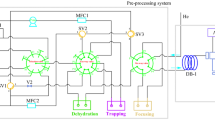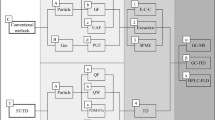Abstract
This study was undertaken to assess the relative bias between two types of sampling methods for volatile organic compounds (VOCs), i.e., sorbent tube vs. bag sampling methods and between different standard phases. For the purpose of this comparative study, gaseous standards containing three major aromatic VOCs (benzene, toluene, and xylene—commonly called BTX) were analyzed by thermo-desorption gas chromatography (TD-GC) with flame ionization detector. According to our findings, the relative response of target compounds can be smaller in the bag method than in the tube method. Although the relative bias varies with the sample transfer conditions for the TD, the mean slope values of the former are smaller by up to 20% relative to the latter, possibly due to sorptive loss on the bag sampler. In addition, the effects of different standard matrices (i.e. liquid and gas phases) were also examined using the sorbent tube method. The results indicated that the slope values of the gas-phase standard were smaller by half (about 43–56%) than the liquid-phase standard. Consequently, information concerning the extent of relative bias between sampling methods (e.g., bag and tube) or standard matrices (e.g., gas and liquid) should be considered as one of the key factors in TD applications.


Similar content being viewed by others
References
Helmig D (1999) Air analysis by gas chromatography. J Chromatogr A 843:129
Demeestere K, Dewulf J, Witte BD, Langenhove HV (2007) Sample preparation for the analysis of volatile organic compounds in air and water matrices. J Chromatogr A 1153:130
Pandey SK, Kim K-H (2009) A review of methods for the determination of reduced sulfur compounds (RSCs) in air. Environ Sci & Tech 29:3020
Ras MR, Borrull F, Marce RM (2009) Sampling and preconcentration techniques for determination of volatile organic compounds in air samples. Trends Analyt Chem 28:347
Matysik S, Matysik F-M (2009) Microextraction by packed sorbent coupled with gas chromatography—mass spectrometry: application to the determination of metabolites of monoterpenes in small volumes of human urine. Microchim Acta 166:109
Bocchini P, Monaco DD, Pozzi R, Pinelli F, Galletti GC (2009) Solid-phase microextraction coupled to gas chromatography with flame ionization detection for monitoring of organic solvents in working areas. Microchim Acta 165:271
Traube SL, Scoggin KD, Li H, Burns R, Xin H (2009) Field sampling method for quantifying odorants in humid environments. Environ Sci & Tech 42:3745
Ouyang G, Pawliszyn J (2006) Recent developments in SPME for on-site analysis and monitoring. Trends Anal Chem 25:692
Ouyang G, Pawliszyn J (2006) SPME in environmental analysis. Ana BioAnal Chem 386:1059
Xiong G, Cheng Y, Pawliszyn J (2003) On-site calibration method based on stepwise solid-phase microextraction. J Chromatogr A 999:43
Li K, Santilli A, Goldthorp M, Whiticar S, Lambert P, Fingas M (2001) Solvent vapour monitoring in work space by solid phase micro extraction. J Hazard Mater 83:83
Demeestere K, Dewulf J, De Roo K, Langenhove HV (2008) Quality control in quantification of volatile organic compounds analysed by thermal desorption—gas chromatography—mass spectrometry. J Chromatogr A 1186:348
Kim K-H (2006) The properties of calibration errors in the analysis of reduced sulfur compounds by the combination of a loop injection system and gas chromatography with pulsed flame photometric detection. Anal Chim Acta 566:75
Pandey SK, Kim K-H (2009) Comparison of different calibration approaches in the application of thermal desorption technique: a test on gaseous reduced sulfur compounds. Microchem J 91:40
Air Server/MCS User Manual (2006) http://www.markes.com
Acknowledgements
This work was supported by the National Research Foundation of Korea (NRF) grant funded by the Ministry of Education, Science and Technology (MEST) (No. 2009-0093848). This study was also aided partially by “Cooperative & Special Graduate Degree Programs for Framework Convention on Climate Change” under the co-sponsorship of the “Korean Ministry of Knowledge Economy” and “Korea Institute of Energy Technology Evaluation and Planning” (Project No 20090142).
Author information
Authors and Affiliations
Corresponding author
Electronic supplementary material
Below is the link to the electronic supplementary material.
Esm 1
(DOC 176 kb)
Rights and permissions
About this article
Cite this article
Kim, KH., Anthwal, A., Sohn, J.R. et al. The role of sample collection method and the bias between different standard matrices in the determination of volatile organic compounds in air. Microchim Acta 170, 83–90 (2010). https://doi.org/10.1007/s00604-010-0394-1
Received:
Accepted:
Published:
Issue Date:
DOI: https://doi.org/10.1007/s00604-010-0394-1




